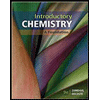
Mastering Chemistry with Pearson eText -- Standalone Access Card -- for Introductory Chemistry (6th Edition)
6th Edition
ISBN: 9780134565927
Author: Nivaldo J. Tro
Publisher: PEARSON
expand_more
expand_more
format_list_bulleted
Concept explainers
Textbook Question
Chapter 8, Problem 11E
Consider the generic
A+2B→C+D
Suppose you have 12 g of A and 24 g of B. Which statement is true?
a. A will definitely be the limiting reactant.
b. B will definitely be the limiting reactant.
c. A will be the limiting reactant if its molar mass is less than B.
d. A will be the limiting reactant if its molar mass is greater than B.
Expert Solution & Answer
Want to see the full answer?
Check out a sample textbook solution
Students have asked these similar questions
Come and compare the Bronsted-Bjerrum calculation, the Debye and Hückel calculation, and the Davies calculation.
plz watch the youtube video (the title of this topic) by roxi H. she explains it step by step but i get the wrong answer
Writing the rate law implied by a simple mechanism
To exit full screen, press and hold esc
Suppose the decomposition of ozone proceeds by the following mechanism:
step
elementary reaction
rate constant
1
→>>
O3(9) O2(g) + O(g)
k₁
2
03(g) + O(g)
→
202(g)
k2
Suppose also k₁ »k2. That is, the first step is much faster than the second.
Write the balanced
chemical equation for the
overall chemical reaction:
Write the experimentally-
observable rate law for the
overall chemical reaction.
☐
rate
=
☐
Note: your answer should
not contain the
concentrations of any
intermediates.
Express the rate constant
k for the overall chemical
reaction in terms of K1, K2,
and (if necessary) the rate
constants k-1 and K-2 for
the reverse of the two
elementary reactions in
the mechanism.
k =
☐
000
18
ローロ
Ar
OO
Chapter 8 Solutions
Mastering Chemistry with Pearson eText -- Standalone Access Card -- for Introductory Chemistry (6th Edition)
Ch. 8 - Q1. Sulfur and fluorine react to form sulfur...Ch. 8 - Hydrogen chloride gas and oxygen gas react to form...Ch. 8 - Sodium reacts with fluorine to form sodium...Ch. 8 - Consider the hypothetical reaction shown here. If...Ch. 8 - Prob. 5SAQCh. 8 - Prob. 6SAQCh. 8 - Sodium and chlorine react to form sodium chloride....Ch. 8 - A reaction has a theoretical yield of 22.8 g. when...Ch. 8 - Titanium can be obtained from its oxide by the...Ch. 8 - Which statement best describes an exothermic...
Ch. 8 - Consider the generic reaction: A+2BAB2Hrxn=155kJ...Ch. 8 - Q12. Hydrogen gas reacts with oxygen to form...Ch. 8 - Prob. 1ECh. 8 - Nitrogen and hydrogen can react to from ammonia:...Ch. 8 - 3. Write the conversion factor that you would use...Ch. 8 - 4. What is wrong with this statement in reference...Ch. 8 - 5 what is the general from of the solution map...Ch. 8 - 6. Consider the recipe for making tomato and...Ch. 8 - 7 In a chemical reaction, what is the limiting...Ch. 8 - Prob. 8ECh. 8 - In a chemical reaction, what are the actual yield...Ch. 8 - If you are given a chemical equation and specific...Ch. 8 - 11. Consider the generic chemical...Ch. 8 - Prob. 12ECh. 8 - What is the enthalpy of reaction (Hrxn)? Why is...Ch. 8 - Explain the relationship between the sign of Hrxn...Ch. 8 - Consider the generic chemical reaction: A+2BC How...Ch. 8 - Consider the generic chemical reaction: 2A+3B3C...Ch. 8 - 17. For the reaction shown, calculate how many...Ch. 8 - 18. For the reaction shown, calculate how many...Ch. 8 - 19. Dihydrogen monosulfide reacts with sulfur...Ch. 8 - 20. Chlorine gas reacts with fluorine gas...Ch. 8 - For each reaction, calculate how many moles of...Ch. 8 - 22. For each reaction, calculate how many moles of...Ch. 8 - 23. For the reaction shown, calculate how many...Ch. 8 - 24. For the reaction shown, calculate how many...Ch. 8 - Consider the balanced equation:...Ch. 8 - 26. Consider the balance equation:
Complete the...Ch. 8 - 27. Consider the unbalanced equation for the...Ch. 8 - 28. Consider the unbalanced equation for the...Ch. 8 - 29. Consider the unbalanced equation for the...Ch. 8 - 30. Consider the unbalanced equation for the...Ch. 8 - Prob. 31ECh. 8 - 32. For the reaction shown, calculate how many...Ch. 8 - For each of the reactions, calculate how many...Ch. 8 - 34. For each of the reactions, calculate how many...Ch. 8 - 35. For the reaction shown, calculate how many...Ch. 8 - 36. For the reaction shown, calculate how many...Ch. 8 - Prob. 37ECh. 8 - Consider the balanced equation for the combustion...Ch. 8 - 39. For each acid–base reaction, calculate how...Ch. 8 - 40. For each precipitation reaction, calculate how...Ch. 8 - Sulfuric acid can dissolve aluminum metal...Ch. 8 - Hydrochloric acid can dissolve solid iron...Ch. 8 - 43. Consider the generic chemical equation:
a....Ch. 8 - Prob. 44ECh. 8 - Prob. 45ECh. 8 - Prob. 46ECh. 8 - For the reaction shown, find the limiting reactant...Ch. 8 - For the reaction shown, find the limiting reactant...Ch. 8 - 49. For the reaction shown, calculate the...Ch. 8 - For the reaction shown, calculate the theoretical...Ch. 8 - Consider the generic reaction between reactants A...Ch. 8 - Consider the reaction between reactants S and O2:...Ch. 8 - Consider the reaction 4HCI(g)+O2(g)2H2O(g)+2Cl2(g)...Ch. 8 - 54. Consider the reaction
Each molecular diagram...Ch. 8 - 55. For the reaction shown, find the limiting...Ch. 8 - For the reaction shown, find the limiting reactant...Ch. 8 - For the reaction shown, calculate the theoretical...Ch. 8 - For the reaction shown, calculate the theoretical...Ch. 8 - 58. If the theoretical yield of a reaction is 24.8...Ch. 8 - If the theoretical yield of reaction is 0.118 g...Ch. 8 - 61. Consider the reaction between calcium oxide...Ch. 8 - Consider the reaction between sulfur trioxide and...Ch. 8 - Consider the reaction between NiS2 and O2:...Ch. 8 - Consider the reaction between HCI and O2...Ch. 8 - Lead ions can be precipitate form solution with...Ch. 8 -
Ch. 8 - Consider the reaction between TiO2 and C:...Ch. 8 - 68. Consider the raction between N2H4 and N2O4:
A...Ch. 8 - 69. Classify each process as exothermic or...Ch. 8 - 70. Classify each process as exothermic or...Ch. 8 - Consider the generic reaction: A+2BCHrxn=55kJ...Ch. 8 - Prob. 72ECh. 8 - Consider the equation for the combustion of...Ch. 8 - The equation for the combustion of CH4 (the main...Ch. 8 - 75. Octane (C8H18) is a component of gasoline that...Ch. 8 - 76. The evaporation of water is...Ch. 8 - Consider the reaction:...Ch. 8 - Prob. 78ECh. 8 - A solution contains an unknown mass of dissolved...Ch. 8 - 80. A solution contains an unknown mass of...Ch. 8 - 81. Sodium bicarbonate is often used as an antacid...Ch. 8 - Toilet bowl cleaners often contain hydrochloric...Ch. 8 - 83. The combustion of gasoline produces carbon...Ch. 8 - Many home barbecues are fueled with propane gas...Ch. 8 - Prob. 85ECh. 8 - 86. Magnesium ions can be precipitated from...Ch. 8 - Hydrogen gas can be prepared in the laboratory by...Ch. 8 - Sodium peroxide (Na2O2) reacts with water to form...Ch. 8 - Prob. 89ECh. 8 - Pure oxygen gas can be prepared in the laboratory...Ch. 8 - 91. Aspirin can be made in the laboratory by...Ch. 8 - 92. The combustion of liquid ethanol produces...Ch. 8 - Urea (CH4N2 O), a common fertilizer, can be...Ch. 8 - 94. Silicon, which occurs in nature as SiO2, is...Ch. 8 - 95. The ingestion of lead from food, water, or...Ch. 8 - Prob. 96ECh. 8 - The propane fuel (C3H8) used in gas barbecues...Ch. 8 - Charcoal is primarily carbon. Determine the mass...Ch. 8 - 99. A loud classroom demonstration involves...Ch. 8 - 100. A hydrochloric acid solution will neutralize...Ch. 8 - 101. Scientists have grown progressively more...Ch. 8 - Prob. 102ECh. 8 - What volume of air is needed to burn an entire...Ch. 8 - Have each member of your group choose a...Ch. 8 - 105. Consider the combustion of propane:
a....
Knowledge Booster
Learn more about
Need a deep-dive on the concept behind this application? Look no further. Learn more about this topic, chemistry and related others by exploring similar questions and additional content below.Similar questions
- Deducing a rate law from the change in concentration over time To exit full screen, press and hold esc A chemistry graduate student is studying the rate of this reaction: H2CO3(aq) → H₂O(aq) +CO₂ (aq) - She fills a reaction vessel with H2CO3 and measures its concentration as the reaction proceeds: time (milliseconds) [H2CO3] 0 0.0500 M 10. 0.0266M 20. 0.0181 M 30. 0.0138M 40. 0.0111 M Use this data to answer the following questions. Write the rate law for this reaction. Calculate the value of the rate constant k. Round your answer to 2 significant digits. Also be sure your answer has the correct unit symbol. rate ☐ x10 k = Х 000 18 Ararrow_forwardWriting the rate law implied by a simple mechanism Suppose the formation of tert-butanol proceeds by the following mechanism: step elementary reaction 1 (CH3)3 CBr(aq) → (CH3)2 C* (aq) + Br (aq) 2 (CH3)2C (aq) + OH¯ (aq) → (CH3)2COH(aq) rate constant k₁ k₂ Suppose also k₁ »k2. That is, the first step is much faster than the second. Write the balanced chemical equation for the overall chemical reaction: Write the experimentally- observable rate law for the overall chemical reaction. Note: your answer should not contain the concentrations of any intermediates. rate = k ☐ Express the rate constant k for the overall chemical reaction in terms of K1, K2, and (if necessary) the rate constants k-1 and K-2 for the reverse of the two elementary reactions in the mechanism. k = ☐ □ ☑ G ? 00. 18 Ar Barrow_forwardDeducing a rate law from the change in concentration over time A chemistry graduate student is studying the rate of this reaction: 2SO3 (g) →>> 2SO2 (g) + O2(g) He fills a reaction vessel with SO3 and measures its concentration as the reaction proceeds: ? time (minutes) [SO3] 0 0.0200M 1.0 0.0105 M 2.0 0.00552M 3.0 0.00290M 4.0 0.00152M Use this data to answer the following questions. Write the rate law for this reaction. rate = k ☐ x10 Calculate the value of the rate constant k. Round your answer to 2 significant digits. Also be sure your answer has the correct unit symbol. k = ☐ Х 000 18 Ar BAarrow_forward
- Using the Arrhenius equation to calculate k at one temperature from k at... The rate constant of a certain reaction is known to obey the Arrhenius equation, and to have an activation energy E reaction is 1.2 × 107 M −1 .S at 160.0 °C, what will the rate constant be at 194.0 °C? Round your answer to 2 significant digits. k = Шм −1 -1 .S ☐ x10 ☑ 5 = = 16.0 kJ/mol. If the rate constant of this a ? olo Ar Barrow_forwardUsing the Arrhenius equation to calculate k at one temperature from k at... a The rate constant of a certain reaction is known to obey the Arrhenius equation, and to have an activation energy E = 10.0 kJ/mol. If the rate constant of this reaction is 9.9 × 107 M -1 .S at 246.0 °C, what will the rate constant be at 196.0 °C? Round your answer to 2 significant digits. k = ☐ M -1 −1 .S x10 ☑ ? 00. 18 Ar Barrow_forwardWriting the rate law implied by a simple mechanism Suppose the reaction between nitric oxide and bromine proceeds by the following mechanism: elementary reaction - NO(g) + Br2(g) → NOBг2(g) step 1 2 NOBг2(g) + NO(g) - rate constant k₁ 2 NOBr(g) k2 Suppose also k₁ »k2. That is, the first step is much faster than the second. Write the balanced chemical equation for the overall chemical reaction: Write the experimentally- observable rate law for the overall chemical reaction. Note: your answer should not contain the concentrations of any intermediates. ☐ rate = k Express the rate constant k for the overall chemical reaction in terms of k₁, k2, and (if necessary) the rate constants k-1 and K-2 for the reverse of the two elementary reactions in the mechanism. = ☐ ロ→ロ Х ك ? 000 18 Ararrow_forward
- Deducing a rate law from the change in concentration over time chemistry graduate student is studying the rate of this reaction: 2H3PO4 (aq) → P₂O5 (aq) +3H₂O (aq) 2 e fills a reaction vessel with H3PO and measures its concentration as the reaction proceeds: 4 time (seconds) [H3PO4] 0 0.500M 1.0 0.229 M 2.0 0.148M 3.0 0.110M 4.0 0.0871 M se this data to answer the following questions. Write the rate law for this reaction. rate = k x10 Calculate the value of the rate constant k. k = Round your answer to 2 significant digits. Also be sure your answer has the correct unit symbol. ☑ G olo 18 Ararrow_forwardWriting the rate law implied by a simple mechanism Suppose the formation of nitrosyl chloride proceeds by the following mechanism: elementary reaction step rate constant 1 NO(g) + Cl2(g) → NOC₁₂(g) k₁ 2 NOCl2(g) + NO(g) 2 NOCl(g) →>> k2 Suppose also k₁ »k. That is, the first step is much faster than the second. Write the balanced chemical equation for the overall chemical reaction: Write the experimentally- observable rate law for the overall chemical reaction. rate = k ☐ Note: your answer should not contain the concentrations of any intermediates. Express the rate constant k for the overall chemical reaction in terms of K1, K2, and (if necessary) the rate constants k-1 and K-2 for the reverse of the two elementary reactions in the mechanism. k = | Х ? 18 Ararrow_forwardUsing first- and second-order integrated rate laws 1/5 Consider this reaction: H2CO3(aq) → H₂O (aq) +CO₂ (aq) At a certain temperature it obeys this rate law. rate = (2.27 s¹) [H2CO3] Suppose a vessel contains H2CO3 at a concentration of 0.830M. Calculate how long it takes for the concentration of H2CO3 to decrease by 83.0%. You may assume no other reaction is important. Round your answer to 2 significant digits. S x10 ☑ § ? 00. 18 Ararrow_forward
- Using the Arrhenius equation to calculate k at one temperature from k at... Try Again Your answer is incorrect. 0/5 a The rate constant of a certain reaction is known to obey the Arrhenius equation, and to have an activation energy E = 28.0 kJ/mol. If the rate constant of this -1 -1 reaction is 2.5 × 10³ M ·S at 45.0 °C, what will the rate constant be at 104.0 °C? Round your answer to 2 significant digits. ST -1 -1 ☐ x10 k = 2.8 × 10 - M .S 18 Ararrow_forwardIn the theory of the state of transition, indicate the expression of the constant k in function of deltaE0#. This expression is also the ecuation of Arrhenius?arrow_forwardBriefly indicate the differences between Ea of the theory of collisions and E0# the theory of the state of transition.arrow_forward
arrow_back_ios
SEE MORE QUESTIONS
arrow_forward_ios
Recommended textbooks for you
 Introductory Chemistry: A FoundationChemistryISBN:9781337399425Author:Steven S. Zumdahl, Donald J. DeCostePublisher:Cengage Learning
Introductory Chemistry: A FoundationChemistryISBN:9781337399425Author:Steven S. Zumdahl, Donald J. DeCostePublisher:Cengage Learning Chemistry: An Atoms First ApproachChemistryISBN:9781305079243Author:Steven S. Zumdahl, Susan A. ZumdahlPublisher:Cengage Learning
Chemistry: An Atoms First ApproachChemistryISBN:9781305079243Author:Steven S. Zumdahl, Susan A. ZumdahlPublisher:Cengage Learning ChemistryChemistryISBN:9781305957404Author:Steven S. Zumdahl, Susan A. Zumdahl, Donald J. DeCostePublisher:Cengage Learning
ChemistryChemistryISBN:9781305957404Author:Steven S. Zumdahl, Susan A. Zumdahl, Donald J. DeCostePublisher:Cengage Learning
 Chemistry for Engineering StudentsChemistryISBN:9781337398909Author:Lawrence S. Brown, Tom HolmePublisher:Cengage Learning
Chemistry for Engineering StudentsChemistryISBN:9781337398909Author:Lawrence S. Brown, Tom HolmePublisher:Cengage Learning Chemistry: The Molecular ScienceChemistryISBN:9781285199047Author:John W. Moore, Conrad L. StanitskiPublisher:Cengage Learning
Chemistry: The Molecular ScienceChemistryISBN:9781285199047Author:John W. Moore, Conrad L. StanitskiPublisher:Cengage Learning

Introductory Chemistry: A Foundation
Chemistry
ISBN:9781337399425
Author:Steven S. Zumdahl, Donald J. DeCoste
Publisher:Cengage Learning

Chemistry: An Atoms First Approach
Chemistry
ISBN:9781305079243
Author:Steven S. Zumdahl, Susan A. Zumdahl
Publisher:Cengage Learning

Chemistry
Chemistry
ISBN:9781305957404
Author:Steven S. Zumdahl, Susan A. Zumdahl, Donald J. DeCoste
Publisher:Cengage Learning


Chemistry for Engineering Students
Chemistry
ISBN:9781337398909
Author:Lawrence S. Brown, Tom Holme
Publisher:Cengage Learning

Chemistry: The Molecular Science
Chemistry
ISBN:9781285199047
Author:John W. Moore, Conrad L. Stanitski
Publisher:Cengage Learning
Types of Matter: Elements, Compounds and Mixtures; Author: Professor Dave Explains;https://www.youtube.com/watch?v=dggHWvFJ8Xs;License: Standard YouTube License, CC-BY